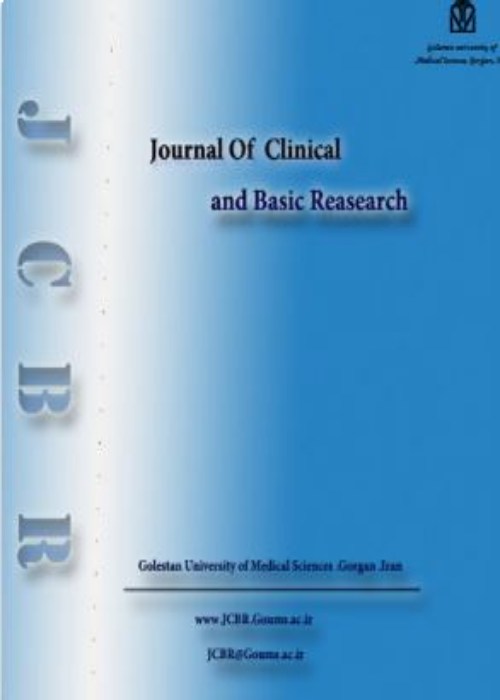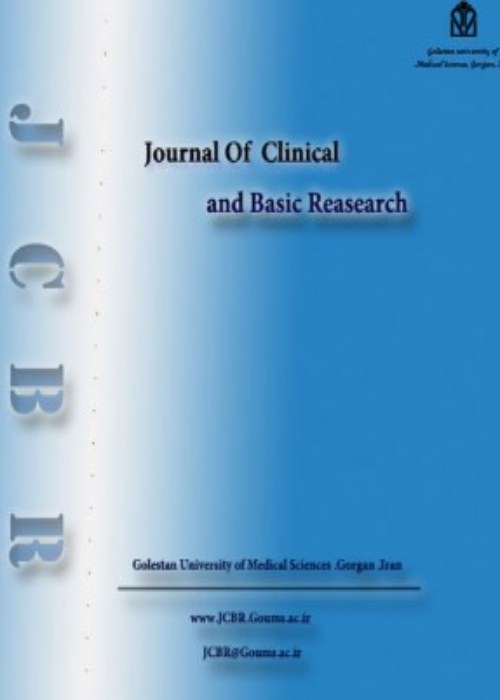فهرست مطالب

Journal of Clinical and Basic Research
Volume:6 Issue: 3, Summer 2022
- تاریخ انتشار: 1401/08/10
- تعداد عناوین: 5
-
Pages 1-9Background and objectives
Surgical site infection (SSI) after colorectal surgery and its negative clinical outcomes remain significant problems. This study aimed to determine the incidence of SSI after colorectal surgery and associated risk factors in the 5 Azar Hospital of Gorgan, Iran.
MethodsA cross-sectional study was performed on patients undergoing emerging or elective colorectal surgeries from 2011 to 2019 in the 5 Azar Hospital of Gorgan, Iran. The subjects were followed up for 30 days. Data were collected through pre and postoperative examinations and telephone follow-ups. Univariate analyses were performed to identify risk factors.
ResultsA total of 240 patients were enrolled in the study, and the overall SSI incidence rate was 23.3% (56 patients). Univariate analyses indicated that corticosteroids use [risk ratio (RR)=3, 95% confidence interval (CI): 1.62-5.54], segmental resection with anastomosis (RR=2.28, 95% CI: 1.12-4.63), anemia (RR=4.52, 95% CI: 3.11-6.59), diabetics (RR=2.68, 95% CI: 1.73-4.14), and opium use (RR=1.87, 95% CI: 1.17-2.99) were risk factors for SSI.
ConclusionBased on our findings, the incidence of SSI after colorectal surgery is relatively high in the study area, which requires tailored approaches and careful reconsideration of the whole operation procedure. Moreover, the use of corticosteroids, type of intervention, anemia, diabetes, and opium use may be associated with the incidence of SSI after colorectal surgery. Therefore, cases with such a profile should be closely monitored after the surgery.
Keywords: Surgical site infection, Colorectal surgery, Risk factors, Incidence -
Pages 10-16Background and objectives
In India, ovarian tumors are the fifth leading cause of death in women. They account for 6% of all cancers in women. The present study aimed to provide support for a new theory of ovarian carcinogenesis by investigating the frequency of ovarian tumors and determining whether the Ki-67 labeling index and p53 overexpression help in differentiating borderline and malignant surface epithelial tumors.
MethodsThe study included all ovarian tumor specimens sent for histopathological examination to the Department of Pathology of Narayana Medical College between June 2017 and October 2019.
ResultsThe frequency of benign epithelial and malignant tumors was 85.47% and 11.97%, respectively. Surface epithelial tumors (81.96%) and germ cell tumors (8.54%) were the most common ovarian tumors. In immunohistochemistry, p53 overexpression in surface epithelial neoplasms showed moderate positivity in all 2 cases of serous carcinomas, while 2 out of 6 mucinous carcinomas cases showed weak positivity. All six cases of mucinous carcinomas showed a Ki-67 labeling index of 26-50%. Serous carcinomas showed a high index of 51%, while mucinous carcinomas had a mean index of 37%. Overexpression of Ki-67 was significantly more common in malignant surface epithelial neoplasms (41.83%) when compared with borderline epithelial neoplasms (27%) (p<0.001).
ConclusionIn comparison to borderline serous and mucinous tumors, Ki-67 overexpression is significantly higher common in malignant surface epithelial tumors. Moreover, p53 overexpression is significantly more common in serous carcinoma when compared with borderline serous tumors but not mucinous tumors. Overall, these markers could be beneficial for diagnosing difficult cases and predicting prognosis.
Keywords: Ki-67, p53, ovarian carcinoma, Immunohistochemistry -
Pages 17-22Background and objectives
One of the leading causes of neonatal death is congenital abnormalities. The most prevalent congenital condition in the world is congenital heart disease (CHD), which affects around one-quarter of all live newborns. Given the significance of CHD, this study aimed to evaluate the prevalence of pediatric congenital heart disease and its variants in Gorgan, northern Iran.
MethodsThis descriptive cross-sectional survey examined 1,416 patients suspected of having CHD who had been referred to the Taleghani Hospital in Gorgan from 2014 to 2016.
ResultsThe most common CHDs were ventricular septal defect (44.92%), atrial septal defect (23.73%), and patent ductus arteriosus (18.63%). Males had a higher rate of transposition of great arteries.
ConclusionThe present study expands our knowledge of the regional frequency of CHD types in children with no acquired heart diseases in Gorgan, Iran. Moreover, ventricular septal defect is the most common type of CHD among patients, mainly males.
Keywords: Cardiac anomalies, ventricular septal defect, atrial septal defect, Congenital Heart Diseases -
Pages 23-26Background and objectives
Bisphenol A (BPA) can impair kidney function via oxidative stress. Glutamine (Gln) is an amino acid with antioxidant and immunomodulatory activities. This study assessed the protective activity of Gln against BPA-induced nephrotoxicity in rats.
MethodsThirty adult male Wistar rats (200-230g) were randomly divided into 6 groups (each containing 5 rats). The rats were orally treated daily for 60 days as follows: Groups A (Control), B, and C were treated with normal saline (0.2 mL), Gln (80 mg/kg), and BPA (50 mg/kg), respectively. Groups D-F were supplemented with 20 mg/kg, 40 mg/kg, and 80 mg/kg of Gln before treatment with BPA (50 mg/kg), respectively. Blood samples were collected and serum renal biochemical markers were measured. The kidneys were weighed and evaluated for oxidative stress markers and histological changes.
ResultsAdministration of BPA decreased body weight (p<0.01) and increased kidney weight (p<0.01) when compared with the control group. The BPA-induced alterations in serum renal biochemical markers were accompanied by elevated urea (p<0.001), creatinine (p<0.001), and uric acid levels (p<0.001) as well as decreased electrolytes (p<0.01) when compared with the control group. Altered kidney oxidative stress markers caused by BPA were marked by a significant decrease in glutathione, catalase, superoxide dismutase and glutathione peroxidase levels (p<0.001) with a significant increase in malondialdehyde levels (p<0.001) compared with the control group. Moreover, BPA caused kidney tubular necrosis, widened bowman’s space, collapsed glomerulus, and lipid accumulation. However, supplementation with Gln (20, 40, and 80 mg/kg) significantly reversed the BPA-induced nephrotoxicity in a dose-dependent manner compared with the BPA group. Furthermore, different doses of Gln restored kidney histology.
ConclusionBased on the results, Gln may have clinical protective effects against BPA-associated nephrotoxicity.
Keywords: Bisphenol A, kidneys, toxicity, glutamine, rats -
Pages 27-29Background
Stüve-Wiedemann syndrome (STWS) is an extremely uncommon disorder, which results in bent-bone dysplasia and dysfunction of the autonomic nervous system that controls involuntary processes, such as body temperature and breathing. In infants, this can result in respiratory distress, feeding and swallowing problems, and hyperthermic episodes. While STWS usually leads to infant mortality, some STWS patients might survive into early adulthood. The condition is caused by a mutation in the leukemia inhibitory factor receptor (LIFR) gene, which is inherited in an autosomal-recessive pattern. In this paper, we present a very rare case of STWS in Qatar.
Case description:
The case was a female baby with the features of STWS. The parents were known carriers of this syndrome with a history of a previous child with the same condition. The baby was the product of a consanguineous marriage. After delivery, the diagnosis of STWS was confirmed by clinical features and genetic testing. Consultation with the related subspecialties was requested for the management of the case.
ConclusionSTWS is a rare disorder accompanied by bent-bone dysplasia and autonomic dysfunction that is generally caused by the autosomal recessive inheritance of a mutated LIFR gene. The symptoms of STWS are the result of a lack of LIFR signaling. There is currently no treatment available for STWS, but the symptoms are managed accordingly.
Keywords: Anomalies, Autosomal recessive, Bent bone dysplasia, Stüve-Wiedemann syndrome


